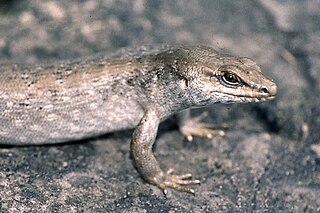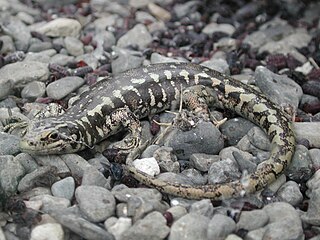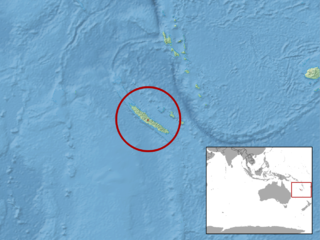
Skinks are lizards belonging to the family Scincidae, a family in the infraorder Scincomorpha. With more than 1,500 described species across 100 different taxonomic genera, the family Scincidae is one of the most diverse families of lizards. Skinks are characterized by their smaller legs in comparison to typical lizards and are found in different habitats except arctic and subarctic regions.

Acritoscincus is a genus of Australian skinks. It belongs to the Eugongylus group; the genus Oligosoma appears to be a fairly close relative. An alternative name is Bassiana.

Carlia is a genus of skinks, commonly known as four-fingered skinks or rainbow skinks, in the subfamily Eugongylinae. Before being placed in this new subfamily, Carlia was recovered in a clade with the genera Niveoscincus, Lampropholis, and others of the Eugongylus group within Lygosominae.

Lampropholis is a genus of skinks, commonly known as sunskinks, in the lizard subfamily Eugongylinae of the family Scincidae. The genus Lampropholis was previously found to belong to a clade with the genera Niveoscincus, Leiolopisma and others of the Eugongylus group within Lygosominae. All species of Lampropholis are endemic to Australia. For similar skinks see genera Bassiana, Pseudemoia, and Niveoscincus.

Leiolopisma is a genus of skinks. Most species occur in the region of New Caledonia-New Zealand, and they are related to other genera from that general area, such as Emoia; these and others form the Eugongylus group. One living and two extinct taxa represent a clade endemic to the Mascarenes.(Austin & Arnold 2006)

Oligosoma is a genus of small to medium-sized skinks found only in New Zealand, Norfolk Island and Lord Howe Island. Oligosoma had previously been found to belong to the Eugongylus group of genera in the subfamily Lygosominae; the Australian genus Bassiana appears to be fairly closely related.

The Otago skink is a rare, endangered species of large skink in the family Scincidae, found in the rocky canyons and grassy patches of Central Otago, New Zealand.

The grand skink is an endangered species of large skink endemic to the central Otago region of New Zealand.

The small-scaled skink is a species of skink in the family Scincidae. The first specimen was captured in 1971 on Motutaiko Island, Lake Taupō but it is now known to be endemic to the central North Island of New Zealand in small population pockets. The holotype is in the collection of the Museum of New Zealand Te Papa Tongarewa.

The slight skink is a skink of the family Scincidae, endemic to the far north of the North Island of New Zealand. The precise distribution is unknown; currently it is only known from localities in the Te Paki region of Northland. It closely resembles the copper skink, Oligosoma aeneum, and was considered to be a member of this species until recently when it was described as a new species using morphological, allozyme and DNA methods. O. levidensum is difficult to distinguish morphologically from O. aeneum, which is probably why it had not been recognised until recently. The main distinguishing feature is the slighter overall body form of O. levidensum compared to O. aeneum. The limbs of O. levidensum are reduced compared to O. aeneum and O. hardyi, the other members of the O. aeneum complex.

Geoscincus is a monotypic genus of skinks: the only accepted species is Geoscincus haraldmeieri.

The Cape Verde giant skink, also called Bibron's skink, Cocteau's skink, and lagarto in Cape Verdean Portuguese, is a recently extinct species of large lizard (skink) that was endemic to some of the Barlavento Islands of Cape Verde before disappearing in the 20th century.

The Burgan skink is a nationally endangered species of skink native to New Zealand. It was described from a specimen found near the Burgan Stream, in the Rock and Pillar Range, Central Otago.

The Nevis skink is a nationally vulnerable species of skink native to New Zealand. It is named in honour of the location of its habitat, the Nevis valley.

The brown skink is a species of skink native to New Zealand.

Eugongylinae is a subfamily of skinks within the family Scincidae. The genera in this subfamily were previously found to belong the Eugongylus group in the large subfamily Lygosominae.

The bar-lipped sheen-skink or unicolor recluse skink, is a species of lizard in the family Scincidae. It is found in Australia (Queensland), the Solomon Islands, Indonesia, and Admiralty Islands.
Eugongylus sulaensis, the Sula skink, is a species of lizard in the family Scincidae. It is found in Indonesia.

Phoboscincus garnieri, also known commonly as Garnier's giant skink and Garnier's skink, is a species of lizard in the family Scincidae. The species is endemic to New Caledonia.

Trachylepis brevicollis, the short-necked skink or Sudan mabuya, is a species of skink found in Sudan, Ethiopia, Eritrea, Somalia, Kenya, Uganda, Tanzania, Yemen, Saudi Arabia, and Oman.



















